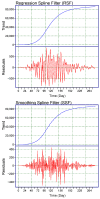Short-Term Forecasting of Monkeypox Cases Using a Novel Filtering and Combining Technique
- PMID: 37296775
- PMCID: PMC10252741
- DOI: 10.3390/diagnostics13111923
Short-Term Forecasting of Monkeypox Cases Using a Novel Filtering and Combining Technique
Abstract
In the modern world, new technologies such as artificial intelligence, machine learning, and big data are essential to support healthcare surveillance systems, especially for monitoring confirmed cases of monkeypox. The statistics of infected and uninfected people worldwide contribute to the growing number of publicly available datasets that can be used to predict early-stage confirmed cases of monkeypox through machine-learning models. Thus, this paper proposes a novel filtering and combination technique for accurate short-term forecasts of infected monkeypox cases. To this end, we first filter the original time series of the cumulative confirmed cases into two new subseries: the long-term trend series and residual series, using the two proposed and one benchmark filter. Then, we predict the filtered subseries using five standard machine learning models and all their possible combination models. Hence, we combine individual forecasting models directly to obtain a final forecast for newly infected cases one day ahead. Four mean errors and a statistical test are performed to verify the proposed methodology's performance. The experimental results show the efficiency and accuracy of the proposed forecasting methodology. To prove the superiority of the proposed approach, four different time series and five different machine learning models were included as benchmarks. The results of this comparison confirmed the dominance of the proposed method. Finally, based on the best combination model, we achieved a forecast of fourteen days (two weeks). This can help to understand the spread and lead to an understanding of the risk, which can be utilized to prevent further spread and enable timely and effective treatment.
Keywords: filtering and combining technique; machine learning models; monkeypox virus; short-term forecasting; time series models.
Conflict of interest statement
The authors declare no conflict of interest.
Figures






Similar articles
-
Modeling and Forecasting Monkeypox Cases Using Stochastic Models.J Clin Med. 2022 Nov 4;11(21):6555. doi: 10.3390/jcm11216555. J Clin Med. 2022. PMID: 36362783 Free PMC article.
-
Real-time forecasting the trajectory of monkeypox outbreaks at the national and global levels, July-October 2022.BMC Med. 2023 Jan 16;21(1):19. doi: 10.1186/s12916-022-02725-2. BMC Med. 2023. PMID: 36647108 Free PMC article.
-
A COVID-19 Pandemic Artificial Intelligence-Based System With Deep Learning Forecasting and Automatic Statistical Data Acquisition: Development and Implementation Study.J Med Internet Res. 2021 May 20;23(5):e27806. doi: 10.2196/27806. J Med Internet Res. 2021. PMID: 33900932 Free PMC article.
-
Modeling and forecasting carbon dioxide emission in Pakistan using a hybrid combination of regression and time series models.Heliyon. 2024 Jun 19;10(13):e33148. doi: 10.1016/j.heliyon.2024.e33148. eCollection 2024 Jul 15. Heliyon. 2024. PMID: 39670222 Free PMC article.
-
A review on COVID-19 forecasting models.Neural Comput Appl. 2021 Feb 4:1-11. doi: 10.1007/s00521-020-05626-8. Online ahead of print. Neural Comput Appl. 2021. PMID: 33564213 Free PMC article. Review.
Cited by
-
Retrospective evaluation of short-term forecast performance of ensemble sub-epidemic frameworks and other time-series models: The 2022-2023 mpox outbreak across multiple geographical scales, July 14th, 2022, through February 26th, 2023.medRxiv [Preprint]. 2023 Oct 17:2023.05.15.23289989. doi: 10.1101/2023.05.15.23289989. medRxiv. 2023. PMID: 37905035 Free PMC article. Preprint.
-
MpoxNet: dual-branch deep residual squeeze and excitation monkeypox classification network with attention mechanism.Front Cell Infect Microbiol. 2024 Jun 7;14:1397316. doi: 10.3389/fcimb.2024.1397316. eCollection 2024. Front Cell Infect Microbiol. 2024. PMID: 38912211 Free PMC article.
-
Evaluating the forecasting performance of ensemble sub-epidemic frameworks and other time series models for the 2022-2023 mpox epidemic.R Soc Open Sci. 2024 Jul 3;11(7):240248. doi: 10.1098/rsos.240248. eCollection 2024 Jul. R Soc Open Sci. 2024. PMID: 39076375 Free PMC article.
-
Optimal features selection in the high dimensional data based on robust technique: Application to different health database.Heliyon. 2024 Sep 2;10(17):e37241. doi: 10.1016/j.heliyon.2024.e37241. eCollection 2024 Sep 15. Heliyon. 2024. PMID: 39296019 Free PMC article. Review.
-
Detection of Monkeypox Cases Based on Symptoms Using XGBoost and Shapley Additive Explanations Methods.Diagnostics (Basel). 2023 Jul 17;13(14):2391. doi: 10.3390/diagnostics13142391. Diagnostics (Basel). 2023. PMID: 37510135 Free PMC article.
References
-
- World Health Organization COVID-19. [(accessed on 17 February 2023)]. Available online: https://covid19.who.int/
LinkOut - more resources
Full Text Sources

